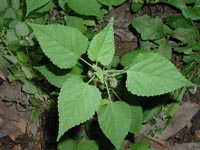Resource Library
Plant of the Week: Mulberry Weed (Hairy Crabweed)
The University of Arkansas System Division of Agriculture does not promote, support or recommend plants featured in "Plant of the Week." Please consult your local Extension office for plants suitable for your region.
Plant of the Week
Hairy Crabweed, Mulberry Weed
Latin: Fatoua villosa

A new weed has entered my life. I first noticed mulberry weed five or six years ago in the greenhouse, but now I battle it in my flowerbeds too. As I travel about the state I see it frequently, so it’s not just a problem for me.
What are the characteristics of mulberry weed?
Mulberry weed (Fatoua villosa) is so named because seedling mulberry trees look similar to the weed when it’s about 4 inches tall with five or six leaves. But mulberries have smooth stems while mulberry weed (also called hairy crabweed, for some unexplained reason) has prominent hairs on the leaves and stems.
It grows stiffly upright to about a foot tall with alternate leaves that are toothed, indented with prominent veins, hairy and yellow-green in color. The leaves have a triangular outline with the petiole about half the length of the leaf blade.
Flowering
The flowers appear as tannish, pea-sized clusters at each node. Unfortunately, mulberry weed is in a hurry to produce seed, so flowers usually appear when plants have only three leaves on them. Plants 2 inches tall are capable of producing copious amounts of seed. Larger plants that get missed in the weeding process produce a truly scary amount of seed.
According to one source, the seeds are explosively discharged and spread up to 4 feet from the original plant. I haven’t directly observed this, but the other greenhouse weeds that give me problems share this characteristic, so I suspect it also happens with this pest too.
This weed belongs to the mulberry family, a not-so-obvious fact when you look at the characteristics of the flower. My first guess at identification was that it belonged to the nettle family, a wrong guess that the first botanist to collect it from Japan also made.
When did mulberry weed find its way into the U.S?
Carl Thunberg collected dried specimens of the weed while stationed in Japan during the late 1700s in the employ of the Dutch East India Company. He provided its first description in the scientific literature.
Mulberry weed’s distribution at the time of Thunberg’s identification is unknown, but today it is widespread in southern Asia, including large parts of south China, the Philippines and Australia. It made its way to this country, probably as a hitchhiker on some imported product, possibly even on equipment returning from World War II.
It was first identified in Louisiana in 1962, but little was heard of it for the next 30 years. Then, sometime in the mid 1990s, it’s suspected to have hitchhiked a ride on nursery stock to gardens all across the southern states.
Mulberry weed prefers a moist, shaded site in the garden. It requires light for germination but is not picky about temperature, germinating from 60 to 90-degree temperatures.
I find no reference to how long the seeds remain viable once deposited in the soil, but as a mostly tropical weed, I suspect their half life when buried will be on the order of a couple years, not a couple decades.
How do I get rid of mulberry weed?
The first line of defense against this pestiferous weed is to learn to identify it. Then, dispatch it post haste to the trash bin. This one does not go in the compost heap because my pile never gets hot enough to kill seeds. Be sure to pull it before the seeds mature, which in landscape beds, is most concentrated in September and October. Because light is needed for germination, one study found that a 2-inch layer of mulch gave good, but not complete, control.
Chemical weed control is easy using any of the direct contact herbicides, but because it grows in such close association with other garden plants, this method is problematic.
Pre-emergence herbicides applied in late March should also be effective. Surflan and Gallery, two common landscape herbicides, have given good control.
By: Gerald Klingaman, retired
Extension Horticulturist - Ornamentals
Extension News - October 1, 2004
The University of Arkansas System Division of Agriculture does not maintain lists of retail outlets where these plants can be purchased. Please check your local nursery or other retail outlets to ask about the availability of these plants for your growing area.